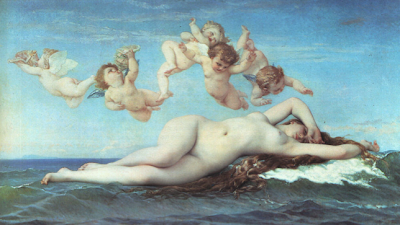'According to usage and conventions which are at last being questioned but have by no means been overcome - men act and women appear. Men look at women. Women watch themselves being looked at’ (Berger 1972)
Hans Memling
‘Vanity’ (1485)
Because she holds the mirror to view herself, it is supposedly okay for us to look at her.
The fact that she is posing naked in the middle of a field/public area, also implies that she wants to be seen.
There was a harsh judgement for Women classed as 'outside the norm' at the time.
For example; Witches.
Here, the woman in the portrait is also admiring herself in the mirror. Her gaze is focusing on herself which insinuates to the viewer that they are welcome to admire her too. There is however a posibility that the Woman is 'unaware' of the viewer in both of these images. It could be that these Women are being looked at through a keyhole, oblivious to the viewer.
Alexandre Cabanel
'Birth of Venus' 1863
Here the Woman laying down, in some ways invites the viewer to look at her. She is surrounded by guardian angels, imposing the connotations of a form of Goddess.
This was the most admired painting of the Salon that year.
Kitschy / mythological / unchallenging / sentimental /unaggressive sexuality (looks away from viewer).
Sophie Dahl for Opium
Here the original use of the reclining pose displayed in the first image was redeemed too sexual for ad standards. To solve this the image was rotated 90degrees clockwise.
Titans Venus of Urbino, 1538
This portrait also shows a Goddess-like image of a nude Woman. This is a more traditional style of painting. The small dog on the end of her bed suggests a connotation of loyalty and companionship. Her expression is flirtatious, although there is a sense of her being unaware of the viewer. It seems like the Woman is being spied on in this scene.
Manet - Olympia 1863
This portrait shows a large contrast in comparison to Titan's Venus of Urbino. Her gaze is also directly towards the viewer, however, here the Woman looks challenging and defensive.
The cat is a symbol of individual femininity and independence.
Olympia ignores the flowers presented to her, probably as a gift to her from an admirer.
Olympia stood “as the first nude to represent modern reality” because she is a prostitute rather than a godess figure. The fact she is a prostitute also implies that she is in more control of her body, as Men would have to pay her money to properly observe her body.
Image 1: Ingres ‘Le Grand Odalisque’ (1814)
Image 2: Guerrilla Girls
Guerrilla Girls formed in 1985 in response to the Museum of Modern Art's exhibition "An International Survey of Recent Painting and Sculpture" which showcased 169 artists; out of those 169, only 17 were women. The curator's press release for the exhibition stated: "Any artist who is not in my show should rethink his career."
Jeff Wall ‘Picture For Women’(1979)
positioning the camera at the centre of the work, so that it captures the act of making the image (the scene reflected in the mirror) and, at the same time, looks straight out at us.
The camera in contemporary media has been put to use as an extension of the
male gaze at women on the streets - Coward R. 1984
Eva Herzignova - Wonderbra 1994
This image was used on billboards. This normalises nudity in the street.
Quote: 'The profusion of images which characterises contemporary society could be seen as an obsessive distancing of women… a form of voyeurism' - Coward R. 1984
•Peeping Tom, 1960
Example where Male bodies are objectified in similar way.
'The issue of male objectification is often raised in gender classes that I have taught. I have heard many men and women suggest that men are now equally objectified in popular culture. Many a people have focused on the Lucky Vanos ads of years past as a sign of advertisers recognizing the desire of women to objectify men in our society. But what is really happening in advertising? Can men be objectified as women? If so, in what frequency is objectification present in ads? The Ads: Consider the number of ads presented in this male trope as compared to other examples of female objectification. It is interesting that when I first began the Web site many years ago, the number of ads in this exhibit were small. Today, there are nearly 60 such ads. '- Dr Scott A Lucas (genderads.com)
Dolce & Gabanna - 2007
Males challenging the Gaze
Ideals of the male image
Marylyn: William Travillas: Dress from The Seven Year
Women artists whose work challenges the Male gaze
Sarah Lucas - Eating a Banana (1990)
Sarah Lucas - Self portait with Fried Eggs (1996)
Tracey Emin - Money Photo (2001)
Caroline Lucas: No More Page Three
wore the white T-shirt at the start of a debate on media sexism.
Chairman of the session, Labour's Jimmy Hood, interrupted her and told her to "put her jacket back on" and comply with Westminster's dress code.
Ms Lucas picked up a copy of The Sun and waved Page Three,
but said she would comply with the ruling.
She added: "It does strike me as a certain irony that this T-shirt is regarded as an inappropriate thing to be wearing in this House, whereas apparently it is appropriate for this kind of newspaper to be available to buy in eight different outlets on the Palace of Westminster estate."
"I'd say it's a constant undercurrent, when women write about feminist issues or are exposed in a lot of media for speaking out about sexism they tend to get a barrage of abuse and threats," she said. (www.bbc.co.uk)


































+1876+Gustave+Caillebotte.jpg)

















